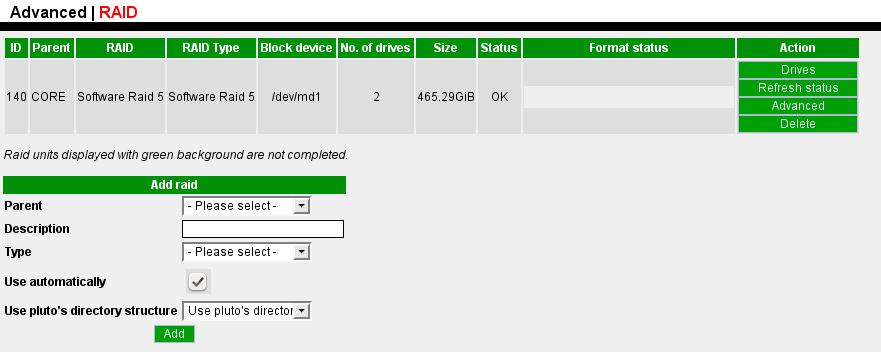Create RAID in LMCE
From LinuxMCE
| Version | Status | Date Updated | Updated By |
|---|---|---|---|
| 710 | Unknown | N/A | N/A |
| 810 | Unknown | N/A | N/A |
| 1004 | Works with hotfix | 13th Mar 2012 | Dirk |
| 1204 | Unknown | N/A | N/A |
| 1404 | Unknown | N/A | N/A |
| Usage Information | |||
Introduction
RAID (Redundant Array of Independent Drives) refers to a data storage scheme which has as a benefit increase of the data integrity, fault-tolerance, throughput and/or capacity There are 3 standard RAID levels which can be used in LMCE, to define RAIDS:
RAID 0
- Striped Set (2 disk minimum) without parity
- provides improved performance
- additional storage
- no fault tolerance from disk errors or disk failure. Any disk failure destroys the array, which becomes more likely with more disks in the array
RAID 1
- Mirrored Set (2 disks minimum) without parity.
- Provides fault tolerance from disk errors and single disk failure.
- Increased read performance occurs when using a multi-threaded operating system that supports split seeks, very small performance reduction when writing.
- A drive has its data duplicated on another different drive. If either drive fails, the other continues to function as a single drive until the failed drive is replaced.
Conceptually simple, RAID 1 is popular for those who require fault tolerance and don't need top-notch read performance.
RAID 5
- Striped Set (3 disk minimum) with Distributed Parity
- Distributed parity requires all but one drive to be present to operate
- drive failure requires replacement, but the array is not destroyed by a single drive failure.
- Upon drive failure, any subsequent reads can be calculated from the distributed parity such that the drive failure is masked from the end user.
- The array will have data loss in the event of a second drive failure and is vulnerable until the data that was on the failed drive is rebuilt onto a replacement drive
Creating RAID
- Go to LinuxMCE Admin Website-->Advanced->Configuration->RAID
- Specify the computer that should hold the RAID in the Parent section.
- Give a Description to the Raid you’re creating.
- Choose the type of RAID, according to what you need to do.
- Check the Use automatically box, if you want your data to be stored automatically using this RAID.
- Choose what kind of data structure you want for this RAID. Then click on the Add button to save your settings.</p>
- Choose the disk drives you want to include in the RAID, by selecting the available ones from the drive list. The list contains only the disks that there are not used. Also you have the option to add spare disks.
- When you have finished adding your disks, press the ‘Create RAID array’ button, to re-write your data in the desired pattern. You will see your RAID created in the list and you will be able to access the advanced configuration page, to add new drives, or to delete it.
- In 10.04, at the moment, a manual fix before reboot seems necessary: sudo mdadm --detail --scan >> /etc/mdadm/mdadm.conf
Note: This is a totally software RAID, you don’t need to activate the RAID in your BIOS.
Troubleshooting
- If the array keeps coming back as failed, try stopping non-existant RAID devices:
- sudo mdadm --stop /dev/md0
- sudo mdadm --stop /dev/md1
- If you continue having problems then try ssh'ing in, delete any partitions using fdisk, reboot and try again.
